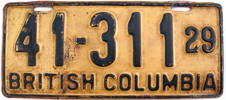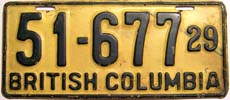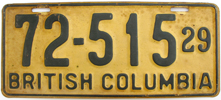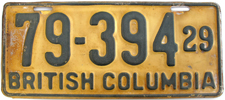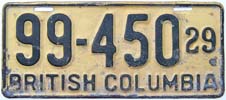|
British
Columbia Passenger License Plates
|
|||||||||||||||||||||||||||||||||||||||||||||||||||||||||||||||||||||||||||||||||||||||||||||||||||||||||||||||||||||||||||||||||||||||||||||||||||||||||||||||||||||||||||||||||||||||||||||||||||||||||||||||||||||||||||||||||||||||||||||||||||||||||||||||||||||||||||||||||||||||||||||||||||||||||||||||||||||||||||||||||||
Quick Links: |
BC license plates issued between 1924 and 1929 and are part of the "Patronage Era" (1918-30) in which the contract for the production of the plates went to politically connected firms. |
* * * * * |
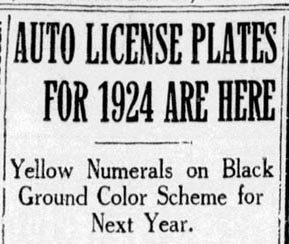 |
| 1924 | |||||||||||||||||||||||
2-digit |
|
||||||||||||||||||||||
1924 also marked the introduction of a unique set of slanted dies - likely in an effort to thwart counterfeiters - that would be used by Tacey through 1927. In 1940, the Vancouver Province decided to run a retrospective piece on how license plates in the province had changed since first being introduced 36 years earlier (e.g. in 1904). Of particular note, it was stated that the design of the dies used for the numbers were inspired by Massachusetts, specifically: |
The peculiar oval or scroll figures now used on the B.C. licenses were designed especially for the inconvenience of those who would tamper with numbers and combinations thereof. This peculiar type has been in use here since 1924, and was originally copied from the plates of Massachusetts. |
As can be seen, while the BC dies share certain commonalities with the Massachusetts dies used on their plates in 1922, particularly between 6 and 9, the numbers 0 to 5 are not really resemble the Massachusetts dies (NOTE: Massachusetts appears to have used the same die types between 1917 and 1925): |
1922 Massachusetts Die Types (0-9) |
|||||||||
 |
 |
 |
 |
 |
 |
 |
 |
 |
 |
1924 British Columbia Die Types (0-9) |
|||||||||
 |
 |
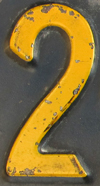 |
 |
 |
 |
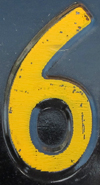 |
 |
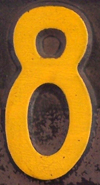 |
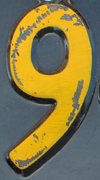 |
Regardless of whether Massachusetts was the sole inspiration for the design of the dies, the style created by Tacey resulted in BC having some of the most distinctive dies in North America over the next 30 years. |
It was also subsequently reported that the dies were "found much more legible at a distance than the block letter style used for several years past." |
* * * * * |

The contract received it usual scrutiny in the Legislature with the Conservative opposition asking the Liberal Government for details on the bidders. On November 11, 1924, Attorney General Manson advised that two bids had been received for the 1925 contract: |
||||
|
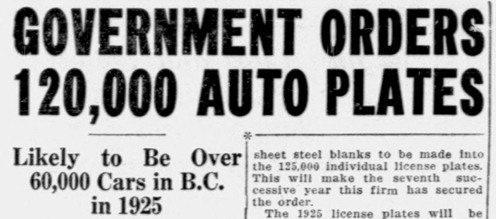 |
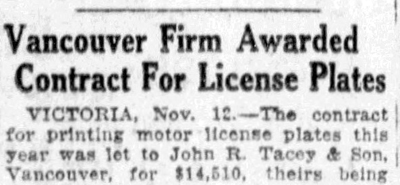 |
| 1925 | |||||||||||||||||||||||
1-digit |
2-digit |
3-digit |
|
||||||||||||||||||||
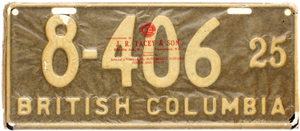 A rare example of a license plate from the 1920s produced by the J.R. Tacey & Son company of Vancouver with its wax paper cover still intact (top right). As their slogan states; "Let British Columbia Flourish by her Industries". A rare example of a license plate from the 1920s produced by the J.R. Tacey & Son company of Vancouver with its wax paper cover still intact (top right). As their slogan states; "Let British Columbia Flourish by her Industries". |
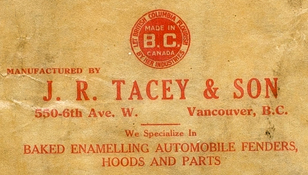 |
* * * * * |
Upon their arrival, the 1926 plates displayed the inverse colour scheme of the 1925 plates (being black-on-white) and the same dies, with the exception of the "-26" which more closely resembled the 1924 plates: |
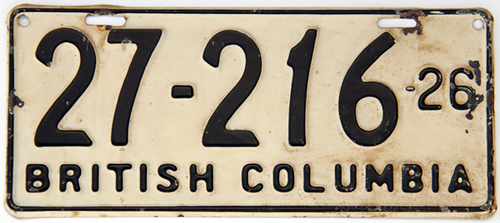 |
| 1926 | |||||||||||||||||||||||
1-digit |
|
||||||||||||||||||||||
On the face of it, this is very odd and raises a valid question as to how "sealed" the bidding process was and if there was information sharing occurring. Regardless, the result was J.R. Tacey & Son had to cut some corners in their use of materials in order to make the numbers work, and this appears to have resulted in the use of sub-standard paints and metal. Not surprisingly, by June of 1926, a mere 6-months after the plates began to be used by motorists, complaints were rolling in about the poor quality. The main issue was the loss of the paint and subsequent illegibility of the plates. According to one report, "from appearances ... it would seem that the enamelling is too light to withstand the continual vibration of the motors and is splitting and chipping." This despite the Tender specifically requiring that only best grade enamel be used in order to guarantee "permanent colors, which will not crack or peel off." With regard to the metal, it was deemed "too light for good service" and, as a result, "the plates are fragile and tend to bend and break with very slight provocation." As one anonymous letter writer ("Britannicus Cynicus") put it in a local newspaper: |
Meandering down Granville Street ... I began taking stock of the conditions of the B.C. automobile license plates ... [and] thought back to a conservation with a fellow camper in a national park south of the border this summer, occasioned by the condition of the plates on my little car, the rear plate being so rusted two numerals were undecipherable, while the front one was an enigma, the black lettering having washed off in the early days of its existence, eliciting the query, "Hello, Stranger, guess it must be kind of wet up there in Vancouver, in more than one sense?" |
More pertinent remarks have been overheard relative to said plates, even the opprobrious word 'graft' having been used ... |
During the past year the writer has observed practically every license plate of Canada and the United States, but none were of such poor quality. One pays enough for a small car license in this province - five and one-half times as much as obtains in California - so we should expect a little something by way of return. |
| 1926 Base Coat Paint Variations | ||
A minor variation can be found with the colour of the base paint applied to the 1926 plates with the white base applied to the initial run, and darker colours applied to plates from the over-run. As can be seen further below, the over-run plates were likely drawn from the base plates being prepared for 1927 (NOTE: the pictures of the back of the plates that follow have been inversed for easier viewing): |
||
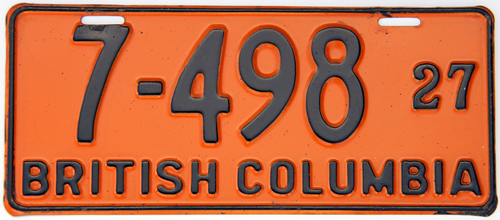
| 1927 | |||||||||||||||||||||||
1-digit |
2-digit |
|
|||||||||||||||||||||
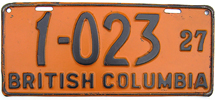 |
|||||||||||||||||||||||
Unfortunately, the appear to have been no questions raised in the Legislative Assembly regarding the 1927 license plate contract, so we don't have information on the number of bidders or the total amount of the contract. |
| Plate Change Over Day |
A festering issue as automobiles became increasingly common and owned by ever more households in the province was licensing costs and the day that new plates could be attached to a vehicle. While vehicle owners could purchase their 1927 plates in mid-December they could not place them on their vehicle until January 1st. If someone had just bought a new car in December, they could purchase their 1927 plates but could not use them until January unless they also paid their quarterly license fee for 1926 (i.e. pay a 3 month fee for 2 weeks of use). In December of 1926, the Vancouver Sun tackled this issue by publishing an Editorial entitled "Early Motor Licenses" in which it pointed out that "Christmas is the natural season for the purchase of automobiles ... [and] this ruling destroys the value of the motor car as a Christmas gift. It knocks the motor dealer's business to pieces each December. It penalizes the pruchaser of cars at this season ... This is inflicting an unnecessary hardship on the motor-buying public of British Columbia." Three days later the Provincial Police provided its response to the Sun's Editorial Board (below-left): |
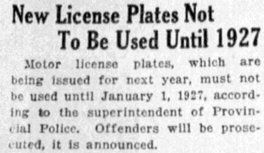 |
 |
| The Vancouver Sun Editorial Board was not amused (above-right), in it's estimation, "better government can be secured by the application of common-sense than by the stubborn application of a rigid set of rules." |
| The irony, of course, being that the Provincial Police would routinely turn a blind eye to motorists using the previous year's license plates until the middle of January - which amounted to a 2-week grace period - before they would begin to enforce the rule that all vehicles had to be displaying the current year's license plates: |
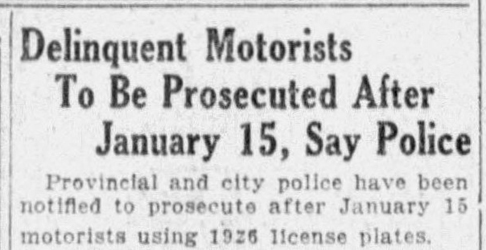 |
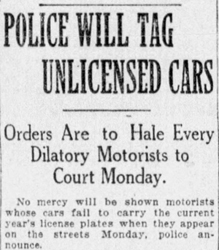 |
A minor variation can be found on the placement of bolt holes on the 1927 base with the first few thousand having holes placed at at the top corners similar to the 1926 design. We have reason to believe that these extra mounting holes can only be found on plates between 1 and 4,000 and and as we get more photos of this base we hope to confirm this. |
Another minor variation can be found with the colour of the base paint applied to the 1927 plates with a darker, burnt orange being used on the initial run and a lighter pumpkin orange used on the subsequent over-run: |
|
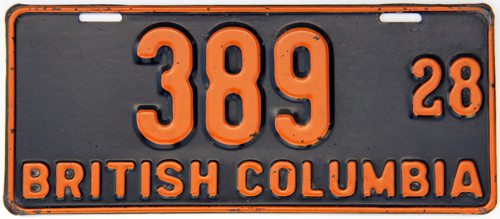 |
| 1928 | |||||||||||||||||||||||
1-digit |
2-digit |
|
|||||||||||||||||||||
| A Salmon or Log shaped plate |
Given plates offered a "cheap and effective" way to promote local industries, it was suggested that British Columbia consider placing one of its many industries, such as lumber, fish, apples and poultry on license plates. In January of 1928, the Victoria Junior Chamber of Commerce picked up the idea and asked the provincial government to have the 1929 license plates manufactured in the shape of a log or salmon as a distinctive way to promote these industry's It was reported that the Junior Chamber went so far as to have "an artist's drawing pictorially describing their ideas prepared." |
As was see on the previous page (1918-23) California had already pioneered the use of imagery on license plates for promotional purposes when it designed a grizzly bear attachment to validate license plates in 1916. Arizona followed suit in 1917 when it stamped the image of a steer-head icon to promote is cattle industry onto its plates. A decade later, Massachusetts placed a cod fish on its plate, Idaho placed a spud on its and PEI included the slogan "Seed Potatoes Foxes" in 1928: |
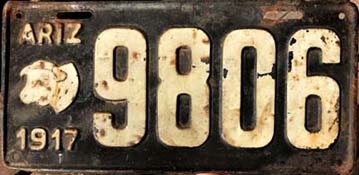 |
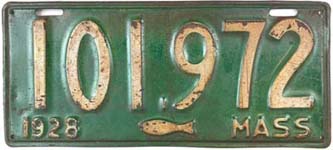 |
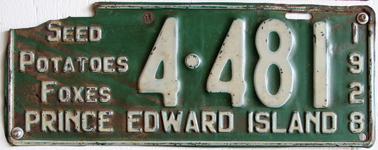 |
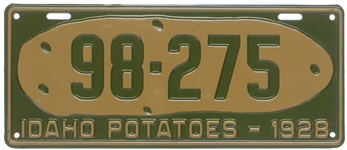 |
Neither the log nor the salmon designs were taken up by the provincial government. |
When preparing the Tender for the 1929 license plate contract, the Provincial Police estimated an 12% growth rate, as this is what had generally be experienced year-over-year previously. This would then result in approximately 94,000 car and a need for an additional 5,000-10,000 license plates above the 90,000 that had been ordered in 1928. |
1929 would mark the twelfth time that J.R. Tacey & Son would win the contract for making BC license plates. It was estimated that the 200,000+ individual license plates (97,000 to 98,000 pairs of passenger sets) would provide steady work for a couple months for upwards of 20 employees. |
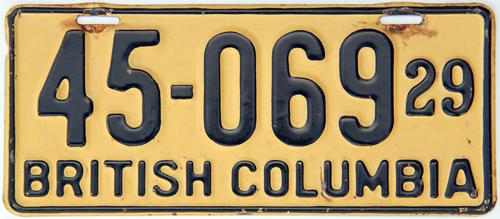
| 1929 | |||||||||||||||||||||||
1-digit |
2-digit |
3-digit
|
|
||||||||||||||||||||
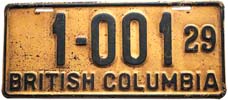 |
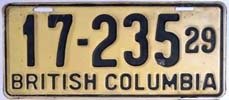 |
||||||||||||||||||||||
| J.R. Tacey & Son: Postscript |
1929 would mark the final time that J.R. Tacey & Son would win the contract to produce British Columbia license plates, having made them continuously from 1918. As will be seen in the coming pages, Tacey would have a short encore in 1930 that would influence the next 30 years of plate designs ... |
John Tacey died on May 23, 1934, at the age of 71 and is buried in Mountain View Cemetery in Vancouver, while his son, Fred Tacey, took over operation of the company in 1940, having renamed it to J.R. Tacey and Company Limited in 1939 before renaming it again to Tacey Sheet Metal Limited the year of his death in 1955 at the age of 63. |
| Out of curiosity, we here at BCpl8s.ca took a look on Google Earth to see what had become of the location where Tacey had his business on 6th Avenue. The block has been completely re-developed and is now home to the offices of the BC Teachers Federation (as of 2022): |
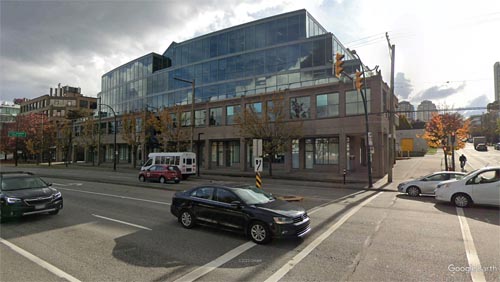 |
Quick Links: |
Antique | APEC | BC Parks | Chauffeur Badges | Collector | Commercial Truck | Consul | Dealer | Decals | Driver's Licences | Farm | Ham Radio | Industrial Vehicle | Keytags | Lieutenant Governor | Logging | Manufacturer | Medical Doctor | Memorial Cross | Motive Fuel | Motor Carrier | Motorcycle | Movie Props | Municipal | National Defence | Off-Road Vehicle | Olympics | Passenger | Personalized | Prorated | Prototype | Public Works | Reciprocity | Repairer | Restricted | Sample | Special Agreement | Temporary Permits | Trailer | Transporter | Veteran | Miscellaneous |
© Copyright Christopher John Garrish. All rights reserved.

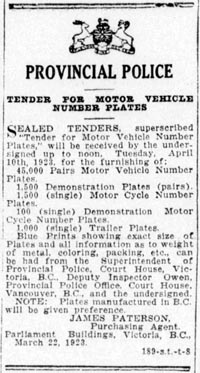
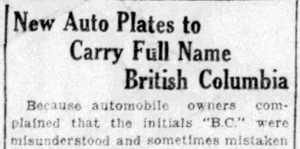 With the acronym gone, the extra space would now be used for a letter to denote the type of vehicle (e.g. a "T" prefix for commercial trucks) and "where the license number runs into four or more figures a dash has been inserted between the figures separating hundreds and thousands." It was also reported that the colours would be yellow-on-black and that the size of the plates would be the same as those issued in 1923.
With the acronym gone, the extra space would now be used for a letter to denote the type of vehicle (e.g. a "T" prefix for commercial trucks) and "where the license number runs into four or more figures a dash has been inserted between the figures separating hundreds and thousands." It was also reported that the colours would be yellow-on-black and that the size of the plates would be the same as those issued in 1923.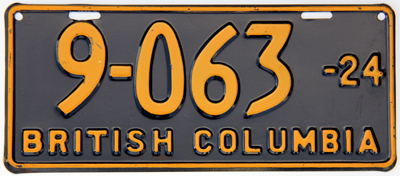
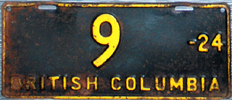
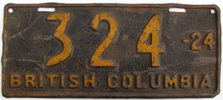
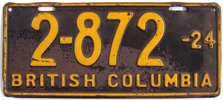
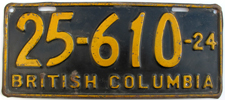
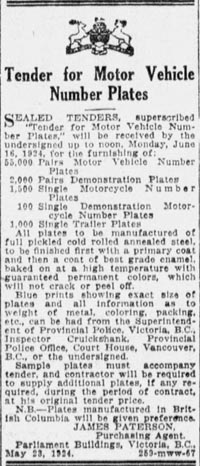
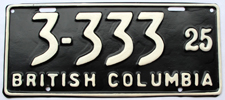
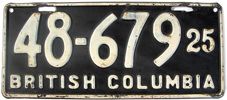
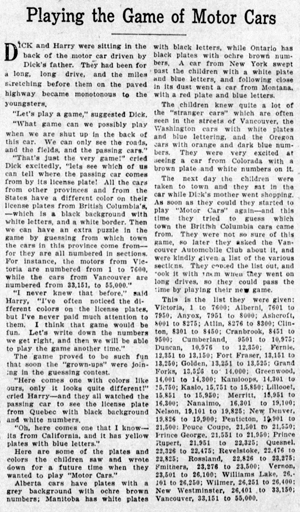

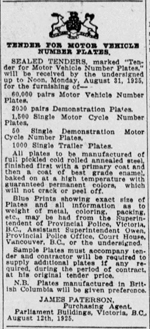
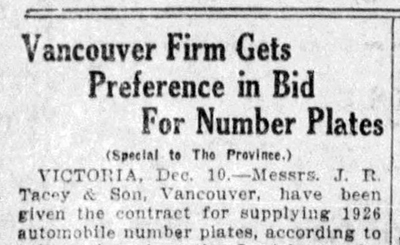 In their annual questioning of the government over the awarding of the license plate contract, the Conservative opposition, through Thomas Coventry, Member for Saanich, asked the Attorney General how many firms had tendered bids, who they were and had the lowest bid been the successful one?
In their annual questioning of the government over the awarding of the license plate contract, the Conservative opposition, through Thomas Coventry, Member for Saanich, asked the Attorney General how many firms had tendered bids, who they were and had the lowest bid been the successful one?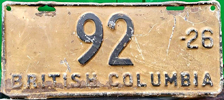
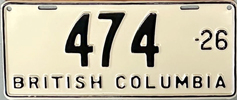
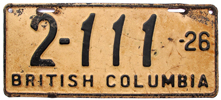
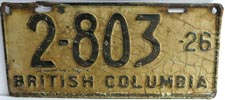
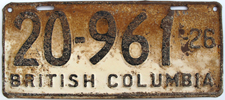
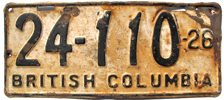
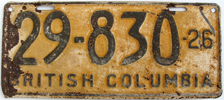
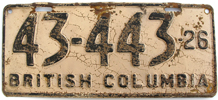
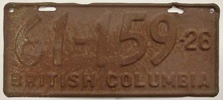
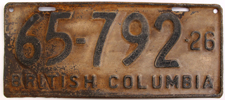
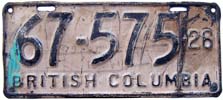
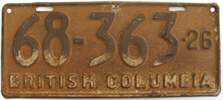
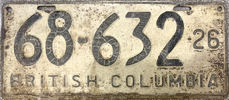
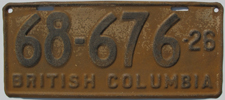
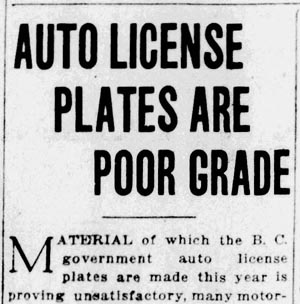 What went wrong with the 1926 plates is not really a matter of much conjecture; Tacey reduced the amount of their bid by 25% from what they had bid in 1925 - despite the number of plates required for 1926 increasing by 10% (if not more).
What went wrong with the 1926 plates is not really a matter of much conjecture; Tacey reduced the amount of their bid by 25% from what they had bid in 1925 - despite the number of plates required for 1926 increasing by 10% (if not more).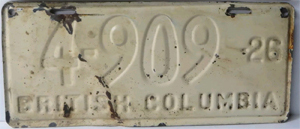
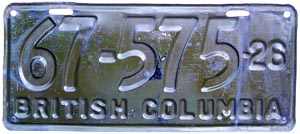
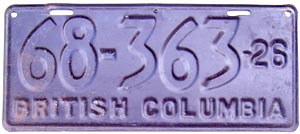

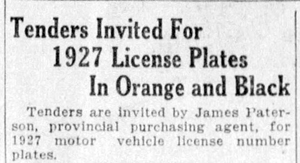 We suspect that this had to do with the complaints being received at this same time about the poor quality of the 1926 plates and not wanting to draw public attention to this aspect of the contract.
We suspect that this had to do with the complaints being received at this same time about the poor quality of the 1926 plates and not wanting to draw public attention to this aspect of the contract.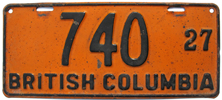
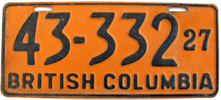
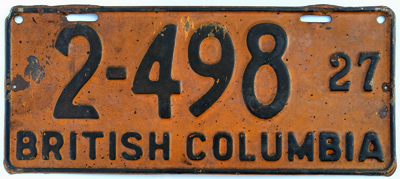
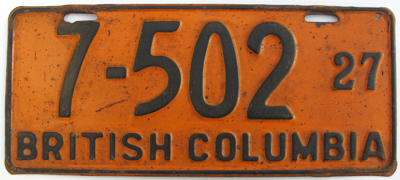
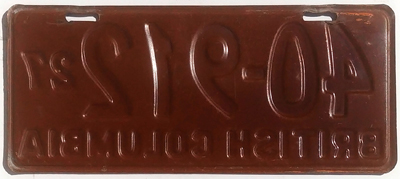
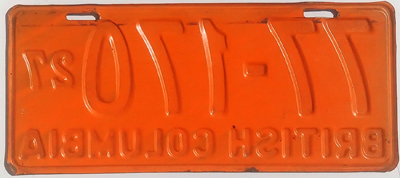
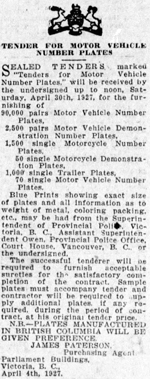
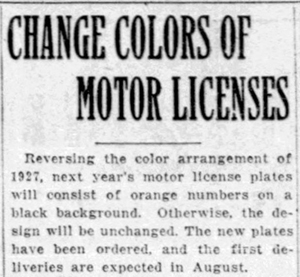 The colours to be used for the 1928 would be orange-on-black, being the reverse of those used in 1927. While the design of the plates remained basically unchanged from the 1927 series, there was one important exception and that was the introduction of new straighter dies for the numbers.
The colours to be used for the 1928 would be orange-on-black, being the reverse of those used in 1927. While the design of the plates remained basically unchanged from the 1927 series, there was one important exception and that was the introduction of new straighter dies for the numbers.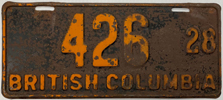
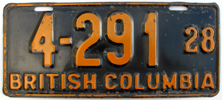
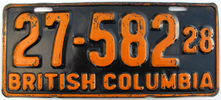
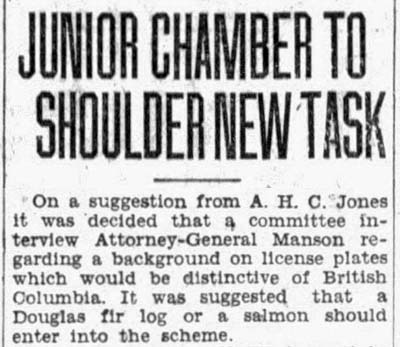 In late 1927, it was reported in the local Vancouver press that "Missouri mules, Georgia oysters, California oranges and Maryland oysters are expected to follow the lead" of Massachusetts and Idaho (NOTE: none of these came to pass) and use their license plates for publicity purposes.
In late 1927, it was reported in the local Vancouver press that "Missouri mules, Georgia oysters, California oranges and Maryland oysters are expected to follow the lead" of Massachusetts and Idaho (NOTE: none of these came to pass) and use their license plates for publicity purposes.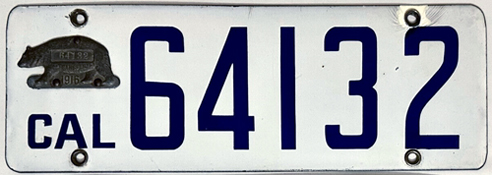
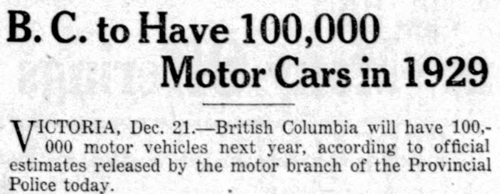
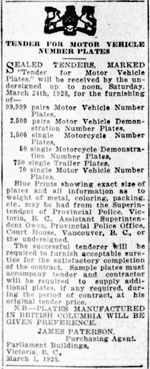
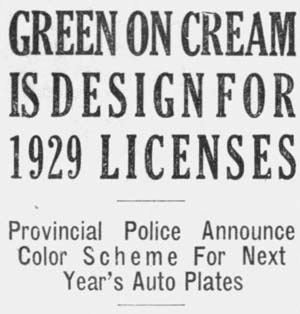 The colours to be used for the 1929 plates were announced to be "green-on-cream", with the green further described as "Paul Revere Green".
The colours to be used for the 1929 plates were announced to be "green-on-cream", with the green further described as "Paul Revere Green".